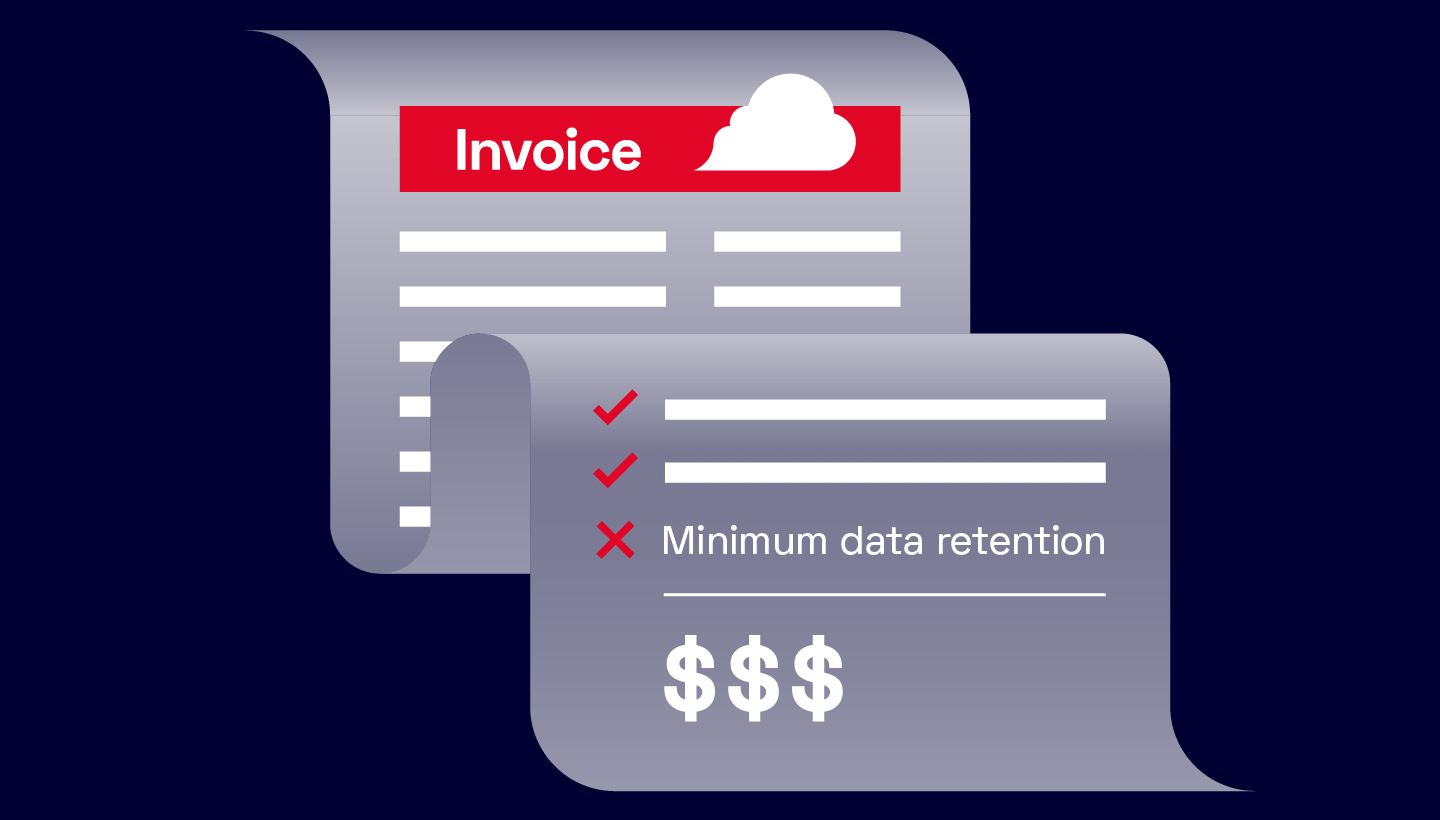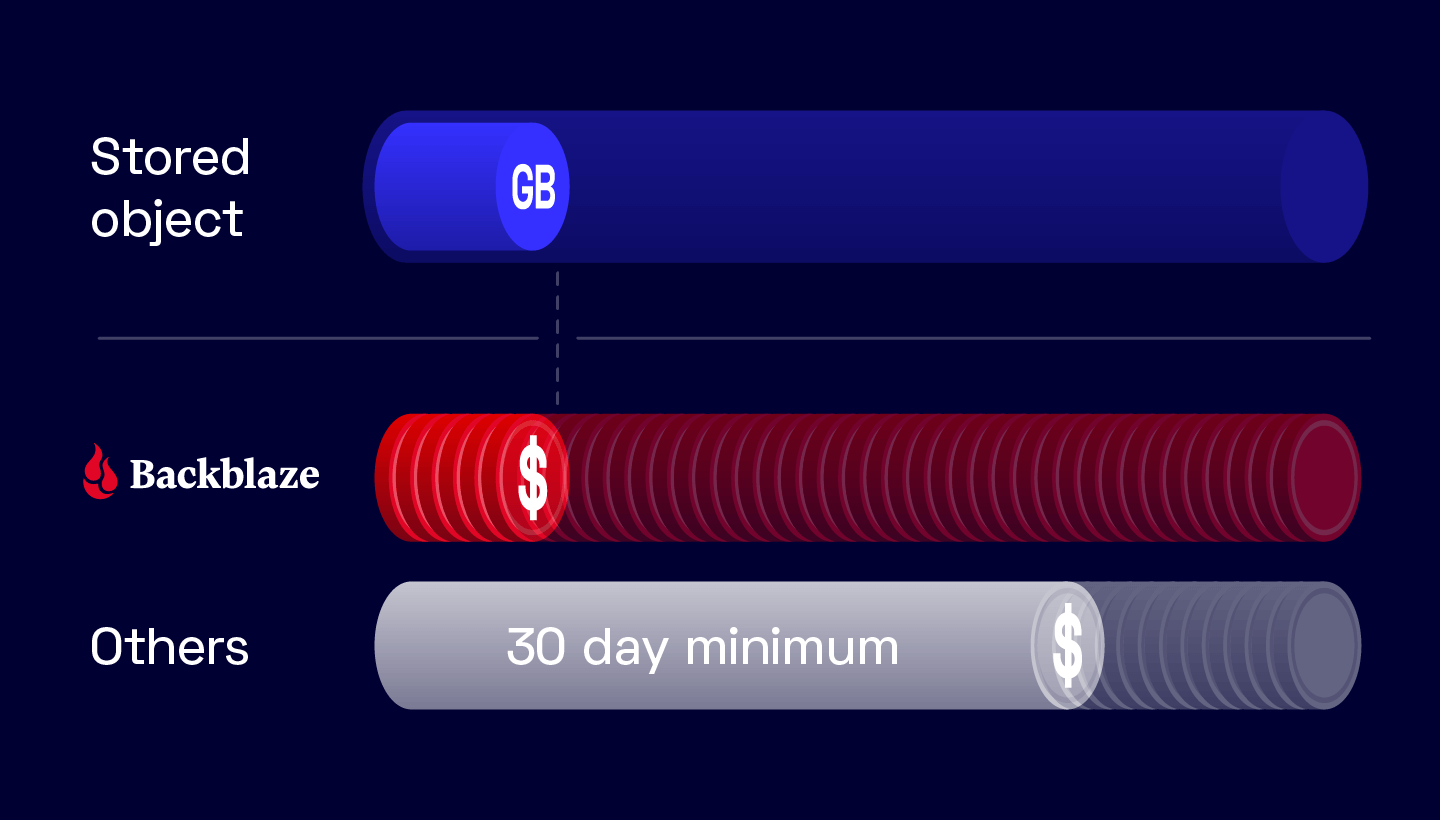
You probably won’t notice a little asterisked footnote tucked at the bottom of the page the first time you read through a cloud storage vendor’s pricing tables. You probably won’t notice it the second or third time either. But you’ll definitely notice it when your bill comes in with charges for data you thought you deleted weeks ago.
That footnote explains an often overlooked challenge to your budget: minimum data retention periods. These policies, used by cloud providers like AWS, Azure, Google Cloud, and Wasabi, can lead to unexpected cost increases and complicated data management strategies.
Today, I’m breaking down cloud storage retention minimums and common scenarios where they directly impact storage budgets and data management policies.
What are minimum data retention periods?
Retention minimums specify the minimum amount of time that data must be stored before it can be deleted, overwritten, or moved to a different storage tier without incurring additional charges.
Cloud storage providers with multiple tiers like AWS or Google Cloud use minimum retention policies to ensure that customers cannot frequently move data between storage tiers to exploit lower-cost storage classes for short-term storage. For cloud providers that have a single class of storage, these policies allow providers to stabilize their resource usage and maintain predictable pricing structures.
Minimum retention periods can vary significantly between providers, and even between different storage tiers offered by the same provider. For example, AWS S3 Standard has no minimum retention period, but S3 Standard-IA has a 30 day minimum, Glacier has a 90 day minimum, and Deep Archive has a 180 day minimum.
Despite their significance, information about these retention periods is often buried in the fine print of service agreements or technical documentation.
What are delete fees?
Delete fees are a direct consequence of deleting or moving files before the retention minimum is met. Cloud providers charge these fees to ensure that the infrastructure allocated for the data is compensated for the resources it would have otherwise used during the retention period. This fee is typically prorated, representing the remaining days in the retention period that the data was meant to occupy in a storage class.
The terms “delete fees,” “minimum storage duration,” and “minimum retention fees” all refer to a similar policy.
How are delete fees incurred?
Early deletion fees can be triggered by various actions, not just the obvious deletion of files. Some examples include:
- Moving data from a higher-cost tier to a lower-cost tier before the minimum retention period has been met: This scenario often catches organizations off guard when they attempt to optimize costs by transferring infrequently accessed data to a cheaper storage class.
- Overwriting existing files: When a file is overwritten, the cloud provider typically treats this as a delete operation followed by a new write operation. If the original file hasn’t met its minimum retention period, the organization may be charged for the remaining time, even though they’re still using the same amount of storage space.

- Implementation of automated lifecycle policies: Many organizations set up rules to automatically move or delete data based on its age or access patterns. However, if these policies don’t account for minimum retention periods, they can inadvertently trigger early delete fees on a large scale.
- Renaming files or folders: Even seemingly benign actions like renaming files or folders can sometimes be interpreted as delete-and-rewrite operations by certain cloud storage systems, potentially triggering these fees.
Additionally, in multi-user or multi-team environments, lack of communication about retention policies can lead to unexpected charges. One team might delete or move data without realizing the financial implications for the entire organization.
The financial impact of minimum data retention periods
Minimum data retention periods, particularly in cold storage tiers, can have significant impacts on IT budgets. What may have seemed like a cost-saving storage tier can actually increase expenses when operations require frequent deletions or movements of data before the minimum retention period is over. But even in hot storage, these policies can unexpectedly inflate overall costs.
To illustrate the real-world impact of retention minimums, let’s examine a few common scenarios:
1. Backup strategy
Let’s say you have a 30 day backup strategy for your critical infrastructure, and you opt for Wasabi object storage to save costs vs. AWS. You plan to keep a month’s worth of backups in the cloud and will then replace them with the newer backups.
Wasabi’s minimum retention policy is 90 days for its Pay as You Go storage (and 30 days for its Reserved Capacity Storage).
You store an initial 50TB of backups in Wasabi on Day 1. On Day 31, the older backup is deleted and replaced with the newer backup. So, you incur costs for 30 days of Timed Active Storage (50TB) and 60 days of Timed Deleted Storage (50TB). These charges are incurred every time the backup is replaced.
With Wasabi’s Pay as You Go storage, your monthly bill will look like this:
50TB x $6.99/TB/month x 3 = $1048.50
We multiply by 3 because the 90 day minimum retention policy equals three months’ time. One of those you’ve actually stored for, and the other two are because you’ve replaced your backups with the new ones.
Compare this to Backblaze B2 Cloud Storage, which has no minimum retention policy and costs $6 per TB/month for its Pay as You Go storage:
50TB x $6/TB/month = $300
The minimum retention policy effectively triples the anticipated storage expenses. When scaled across multiple backup sets or extended periods, the impact on the IT budget can be substantial.
Delete fees in the real world: California university switches to Backblaze to eliminate surprise bills from Wasabi
Cal Poly Humboldt thought they understood cloud storage provider Wasabi’s pricing, but each month brought unexpected charges for deleted data due to Wasabi’s minimum storage retention policies. This, in turn, caused a chain reaction of calls from the procurement office, buying extra capacity, and then modifying the system to try to avoid further bills. To silence the monthly fire alarms, they switched to Backblaze.
With no retention minimums, Cal Poly Humboldt now knows exactly what their Backblaze costs will be up front. The move was so smooth that they migrated another 100TB from Google’s no-longer-free tier for educational institutions and plan to scale their storage to over a petabyte to back up and safeguard research data.

2. Application storage
In application storage use cases, retention minimums can impact cloud spend significantly when the data has a short lifecycle. Applications with high transaction volumes—such as e-commerce, user-generated content applications, or surveillance platforms—frequently upload and delete as part of their daily operations.
For example, most video surveillance platforms may only need 30 days of history for footage that’s been uploaded and processed, so something like a 90-day retention period doesn’t make financial or operational sense. E-commerce customers can also be affected; these businesses have users that frequently upload and delete content to manage storefronts, creating unpredictable data usage patterns. In these cases, you are at the mercy of your end users—if users churn through files quickly you will pay the retention penalties.
3. Video production
Retention minimums also affect video production workflows particularly when you need to make revisions once a project has been archived in cold storage—a common workflow many studios and broadcasting agencies use to get more affordable storage rates for seldom-accessed data.
Whether due to last minute changes in branding, edits to visuals, or adjustments to sound, the project needs to be pulled from storage for further modification. Because the files were moved to colder storage under a 90 day retention policy, accessing and modifying them before that period ends can trigger significant early delete fees.
If you routinely archive files immediately after a project completes anticipating that no further changes will be required, these early delete fees can add up quickly.
The hidden complexities of minimum data retention periods
Retention minimums can significantly impact your bottom line. These policies, often buried in the fine print, can lead to unexpected costs and complicate data management strategies across various industries.
Understanding the nuances of minimum data retention periods and their associated costs is crucial for developing an effective and economically sound cloud storage strategy. It enables organizations to make more informed decisions, avoid unexpected expenses, and better align their storage choices with their specific data management needs and budget constraints.




